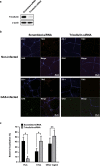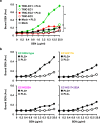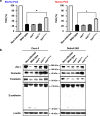Group A Streptococcus exploits human plasminogen for bacterial translocation across epithelial barrier via tricellular tight junctions
- PMID: 26822058
- PMCID: PMC4731814
- DOI: 10.1038/srep20069
Group A Streptococcus exploits human plasminogen for bacterial translocation across epithelial barrier via tricellular tight junctions
Erratum in
-
Erratum: Group A Streptococcus exploits human plasminogen for bacterial translocation across epithelial barrier via tricellular tight junctions.Sci Rep. 2017 Jun 30;7:46388. doi: 10.1038/srep46388. Sci Rep. 2017. PMID: 28664907 Free PMC article.
Abstract
Group A Streptococcus (GAS) is a human-specific pathogen responsible for local suppurative and life-threatening invasive systemic diseases. Interaction of GAS with human plasminogen (PLG) is a salient characteristic for promoting their systemic dissemination. In the present study, a serotype M28 strain was found predominantly localized in tricellular tight junctions of epithelial cells cultured in the presence of PLG. Several lines of evidence indicated that interaction of PLG with tricellulin, a major component of tricellular tight junctions, is crucial for bacterial localization. A site-directed mutagenesis approach revealed that lysine residues at positions 217 and 252 within the extracellular loop of tricellulin play important roles in PLG-binding activity. Additionally, we demonstrated that PLG functions as a molecular bridge between tricellulin and streptococcal surface enolase (SEN). The wild type strain efficiently translocated across the epithelial monolayer, accompanied by cleavage of transmembrane junctional proteins. In contrast, amino acid substitutions in the PLG-binding motif of SEN markedly compromised those activities. Notably, the interaction of PLG with SEN was dependent on PLG species specificity, which influenced the efficiency of bacterial penetration. Our findings provide insight into the mechanism by which GAS exploits host PLG for acceleration of bacterial invasion into deeper tissues via tricellular tight junctions.
Figures






Similar articles
-
[Streptococcus pyogenes translocates across an epithelial barrier].Nihon Saikingaku Zasshi. 2017;72(3):213-218. doi: 10.3412/jsb.72.213. Nihon Saikingaku Zasshi. 2017. PMID: 28845032 Review. Japanese.
-
Defining the structural basis of human plasminogen binding by streptococcal surface enolase.J Biol Chem. 2009 Jun 19;284(25):17129-17137. doi: 10.1074/jbc.M109.004317. Epub 2009 Apr 10. J Biol Chem. 2009. PMID: 19363026 Free PMC article.
-
Tricellular Tight Junction Protein Tricellulin Is Targeted by the Enteropathogenic Escherichia coli Effector EspG1, Leading to Epithelial Barrier Disruption.Infect Immun. 2016 Dec 29;85(1):e00700-16. doi: 10.1128/IAI.00700-16. Print 2017 Jan. Infect Immun. 2016. PMID: 27795363 Free PMC article.
-
Identification of plasminogen-binding sites in Streptococcus suis enolase that contribute to bacterial translocation across the blood-brain barrier.Front Cell Infect Microbiol. 2024 Feb 22;14:1356628. doi: 10.3389/fcimb.2024.1356628. eCollection 2024. Front Cell Infect Microbiol. 2024. PMID: 38456079 Free PMC article.
-
Tricellular Tight Junctions in the Inner Ear.Biomed Res Int. 2016;2016:6137541. doi: 10.1155/2016/6137541. Epub 2016 Apr 18. Biomed Res Int. 2016. PMID: 27195292 Free PMC article. Review.
Cited by
-
Host Pathways of Hemostasis that Regulate Group A Streptococcus pyogenes Pathogenicity.Curr Drug Targets. 2020;21(2):193-201. doi: 10.2174/1389450120666190926152914. Curr Drug Targets. 2020. PMID: 31556853 Free PMC article.
-
The Recruitment and Activation of Plasminogen by Bacteria-The Involvement in Chronic Infection Development.Int J Mol Sci. 2023 Jun 21;24(13):10436. doi: 10.3390/ijms241310436. Int J Mol Sci. 2023. PMID: 37445613 Free PMC article. Review.
-
Variations in the secondary structures of PAM proteins influence their binding affinities to human plasminogen.J Struct Biol. 2019 May 1;206(2):193-203. doi: 10.1016/j.jsb.2019.03.003. Epub 2019 Mar 14. J Struct Biol. 2019. PMID: 30880082 Free PMC article.
-
The Pneumococcal Protein SufC Binds to Host Plasminogen and Promotes Its Conversion into Plasmin.Microorganisms. 2023 Dec 12;11(12):2969. doi: 10.3390/microorganisms11122969. Microorganisms. 2023. PMID: 38138113 Free PMC article.
-
Streptococcus co-opts a conformational lock in human plasminogen to facilitate streptokinase cleavage and bacterial virulence.J Biol Chem. 2021 Jan-Jun;296:100099. doi: 10.1074/jbc.RA120.016262. Epub 2020 Nov 24. J Biol Chem. 2021. PMID: 33208461 Free PMC article.
References
-
- Carapetis J. R., Steer A. C., Mulholland E. K. & Weber M. The global of group A streptococcal diseases. Lancet Infect. Dis. 5, 685–694 (2005). - PubMed
-
- Tart A. H., Walker M. J. & Musser J. M. New understanding of the group A Streptococcus pathogenesis cycle. Trends Microbiol. 15, 318–325 (2007). - PubMed
-
- Carapetis J. R., McDonald M. & Wilson N. J. Acute rheumatic fever. Lancet 366, 155–168 (2005). - PubMed
-
- Tsukita S., Furuse M. & Itoh M. Multifunctional strands in tight junctions. Nat. Rev. Mol. Cell. Biol. 2, 285–293 (2001). - PubMed
-
- Staehelin L. A. Further observations on the fine structure of freeze-cleaved tight junctions. J. Cell Sci. 13, 763–786 (1973). - PubMed
MeSH terms
Substances
LinkOut - more resources
Full Text Sources
Other Literature Sources
Molecular Biology Databases
Research Materials
Miscellaneous

